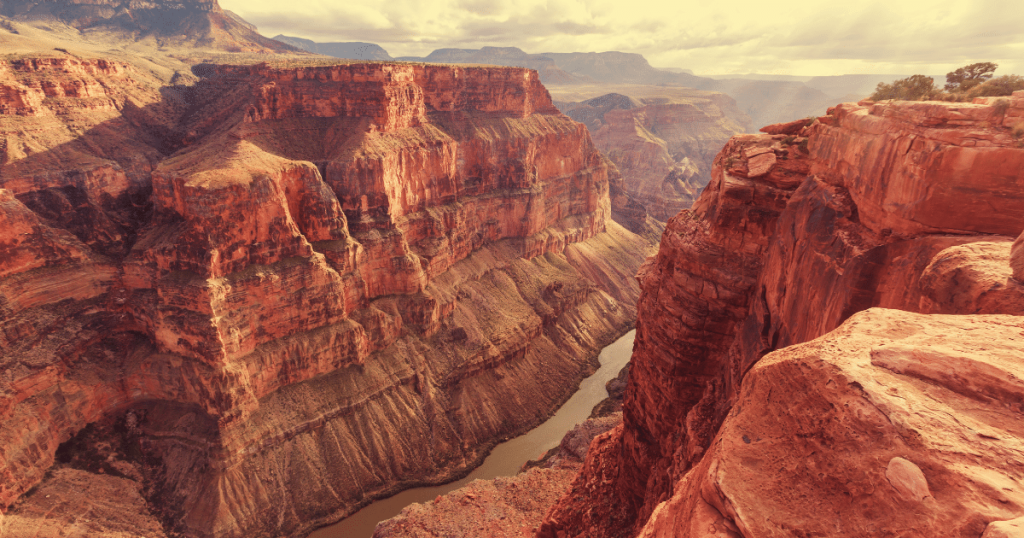Embracing Autumn’s Palette: Grand Canyon in the Fall
The Grand Canyon is one of the most breathtaking landmarks in the world, and it’s no secret why. The sheer size and natural beauty leave visitors captivated and yearning for more. While most tourists prefer visiting in the summer months, the Grand Canyon in the fall is a hidden gem that should not be overlooked. Many consider the fall season to be the best time to visit the Grand Canyon and experience its true grandeur.

Fall Foliage Spectacle
As autumn rolls in, the Grand Canyon transforms into a spectacular canvas of colors. The foliage of cottonwood, willow, and maple trees in the park’s higher elevations paint a stunning spectrum of reds, oranges, and yellows.
Transformation of Canyon Vegetation
As the season transitions from summer to fall, the Grand Canyon’s vegetation undergoes a remarkable transformation. The deciduous trees, which comprise a significant portion of the park’s flora, begin to prepare for winter.
This preparation manifests as a change in the color of the leaves, a phenomenon caused by the reduction of chlorophyll, the green pigment responsible for photosynthesis. This decline in chlorophyll allows other pigments within the leaves, such as carotenoids and anthocyanins, to become visible.
Carotenoids, present in the leaves throughout the year, are responsible for the yellow and orange hues that emerge. Anthocyanins, on the other hand, are newly synthesized during autumn and contribute to the vibrant red and purple shades.
Best Vantage Points for Fall Views
To fully appreciate the spectacle of the Grand Canyon’s autumn display, choosing the right vantage point is crucial. Here are a few recommended spots for optimal fall foliage sightings.
Yaki Point
Located on the South Rim, Yaki Point offers unobstructed views of the canyon. During fall, the foliage in the surrounding areas bursts into a vibrant blend of colors, enhancing the natural beauty of the view.
Bright Angel Trail
For those willing to venture down into the canyon, Bright Angel Trail is a must. As you descend, you’ll witness close-up views of the foliage transformation, offering a unique, immersive experience.
Lesser-Known Spots for Unique Perspectives
While the popular viewpoints offer stunning sights, the Grand Canyon’s lesser-known spots provide unique perspectives and a bit more solitude.

Shoshone Point
A hidden gem on the South Rim, Shoshone Point is an unmarked trail leading to a quiet viewpoint. The isolation of this spot makes it ideal for those seeking to appreciate the fall colors in a peaceful setting.
Point Sublime
As the name suggests, the views from Point Sublime are just that – sublime. Located on the North Rim, this remote viewpoint requires a bit of an adventurous drive but rewards visitors with an unparalleled vista of the Grand Canyon’s autumn palette.
Weather and Ideal Times to Visit
Autumn at the Grand Canyon presents visitors with milder, more comfortable temperatures than the scorching summer months. Average high temperatures in September begin in the mid-70s (Fahrenheit), gradually dropping to the mid-60s by November. However, lows can dip into the 30s, especially in late autumn, so packing layers is recommended for those planning a visit during this season.
The ideal time to visit for fall foliage is typically from mid-October to early November. However, the peak of the color change can vary slightly depending on the weather conditions each year. Early mornings and late afternoons are particularly enchanting as the soft light enhances the vibrant autumn colors.
Fall Hiking Adventures
Autumn is the perfect season to take on the hiking trails of the Grand Canyon. The trails offer a spectrum of difficulty levels, catering to both novice and experienced hikers.
Selecting Fall-Friendly Hiking Trails
Experiencing the fall foliage in the Grand Canyon often involves immersing oneself in nature via the park’s extensive network of hiking trails. These trails not only offer stunning views of the canyon but also showcase the rich tapestry of autumn colors.
Trails that Showcase the Best of Fall Foliage
To savor the full spectrum of fall colors, a few trails stand out. The Rim Trail, stretching over 13 miles along the South Rim, offers panoramic views of the canyon along with close encounters with the golden hues of autumn. The North Kaibab Trail is another excellent choice for fall foliage, particularly its upper sections which wind through a variety of deciduous trees.

Difficulty Levels and Trail Options for Various Hikers
When planning a hiking adventure in the Grand Canyon, it’s important to recognize that trails vary in difficulty. Novice hikers or those seeking a more leisurely pace might opt for the South Rim’s Bright Angel Trail, which, despite being steep in places, is well-maintained and offers rest stops with water sources.
On the other hand, hikers in search of a challenge might gravitate towards the South Kaibab Trail, which provides a steeper path and grand vistas. For those looking for solitude, the Transept Trail on the North Rim offers a peaceful hike through a forest of radiant fall colors.
Wildlife Encounters in the Fall
Autumn in the Grand Canyon is not only a visual treat due to the transforming foliage, but it also offers unique opportunities to observe the park’s diverse wildlife. During this season, many animals are actively preparing for the winter, leading to increased activity and sightings.
Insights into the Behavior of Wildlife During the Season
As the air turns crisper and the days shorter, wildlife in the Grand Canyon engage in a flurry of activities. Elk, for instance, enter their mating season, known as the ‘rut,’ in the fall. The sound of bugling males echoes through the park, providing a unique auditory experience. Squirrels and other small mammals can be seen scurrying about, gathering, and storing food for the winter. Birds, too, are very active, with many species migrating and adding to the park’s avian diversity.
Responsible Wildlife Observation Tips for Hikers
While witnessing the Grand Canyon’s wildlife can be an exciting aspect of any hike, it is crucial to do so responsibly. Here are a few guidelines for hikers:
- Maintain a safe distance: For your safety and the well-being of the animals, keep a reasonable distance. Never feed or touch wildlife.
- Stay quiet: Loud noises can distress and scare wildlife. Speak softly and avoid making sudden noises.
- Keep pets on a leash: If you’re hiking with pets, ensure they’re on a leash and under control at all times.
- Respect wildlife crossings: Animals may cross hiking trails. Allow them to do so without interruption.
- Leave no trace: Always carry out what you carry in. Litter can harm wildlife and degrade their habitat.
Observing these simple rules will ensure a respectful and enjoyable wildlife viewing experience for all visitors.

Fall Camping and Accommodations
Camping during fall in the Grand Canyon is an immersive experience that brings you closer to nature’s spectacle of changing seasons.
Campground Options
There are various campgrounds available, both on the South and North Rims. The Mather Campground on the South Rim is popular due to its proximity to the canyon. Open year-round, it offers tent and RV camping with reservation options available. The North Rim Campground, while more secluded, offers an intimate experience with nature and is less crowded in the fall months.
Amenities and Reservations
Campground amenities typically include tent sites, RV sites (with varying degrees of hookups), picnic tables, fire grills, and restrooms with running water. Some campgrounds also have a dump station for RVs. It’s advisable to make reservations in advance, especially for the busy fall season.
Backcountry Camping
For the more adventurous, backcountry camping is an option. This allows you to camp below the rim, amid the autumn colors. A permit is required for all overnight stays in the backcountry.
Lodging Options
If camping is not your style, there are also several lodges and hotels available within and near the park. These range from the historic El Tovar Hotel on the South Rim to the rustic Grand Canyon Lodge on the North Rim.
Final Thought
The Grand Canyon offers an unforgettable autumn experience, elegantly combining nature’s spectacle with thrilling outdoor activities. From viewing the breathtaking fall foliage on the various hiking trails to encountering diverse wildlife preparing for winter and camping under the starlit sky amidst the changing seasons, the park presents a unique and enriching adventure for every visitor.
Whether you’re a seasoned hiker, wildlife enthusiast, or simply a nature lover seeking tranquility, the Grand Canyon in the fall is bound to exceed your expectations and leave you with memories to cherish.







